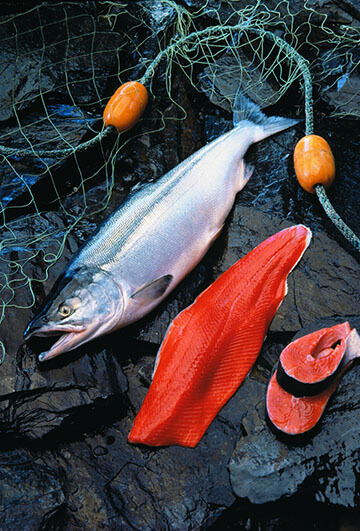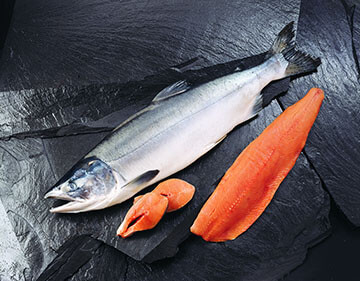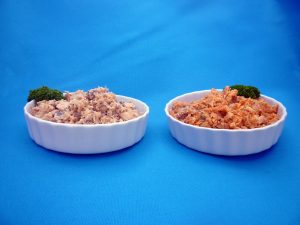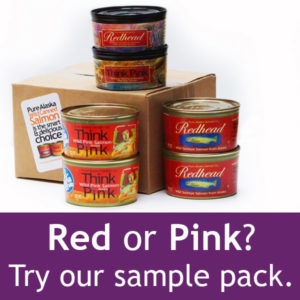Red Salmon Versus Pink Salmon Versus Tuna

Sockeye Salmon, Look at That Unmistakable Color
Pink salmon is inexpensive; red salmon costs more. Red salmon flesh is actually red, and pink salmon looks more like tuna. When red and pink salmon are pulled fresh from the sea their flesh is, in fact, distinctly red or pink. The cooking process of canning reduces coloration in both. Red salmon gets its enhanced color from eating krill, a type of small shrimp. Pinks are the most abundant salmon, followed by reds.
Pink salmon, upon hatching, go directly to the sea, whereas red salmon spend over a year in fresh water. Red salmon need a lake or other large body of fresh water in which to grow. The largest red salmon run in the world by far is in Bristol Bay, Alaska, an area uniquely blessed with a system of saltwater bays and freshwater lakes. The world’s largest pink salmon runs are located in Southeast Alaska, which has a mild climate coupled with abundant rainfall, and thousands of short streams running from landfall directly to the sea.
Why is red salmon more expensive than pink salmon?

Pink Salmon is Pink When Uncooked
Supply and demand and a historic bias for red salmon account for the cost differential. We have done blind taste tests, and when people don’t know which fish they are eating, statistically they report a slight preference for pink over red. When tasters state a bias, they generally insist that red is best. We at Pure Alaska speculate that this preference was established in the days before boat refrigeration, when reds held up in the hatches of fishing boats far better than the more delicate pinks. Admittedly, pink salmon was not a very appetizing food back then. In the past twenty years the Alaska salmon-fishing fleet has invested in chilled circulating seawater fish holds, and this has vastly increased the quality of canned salmon. The salmon are pulled directly from the cold, clear waters and put into the fish holds where they remain until processed at the cannery – typically the same day. The quality of all canned wild Alaska salmon has increased immensely, but the lowly pink salmon has really been transformed.
Tuna vs. Wild Alaska Salmon – Alaska Salmon is the Hand’s Down Winner

Red and Pink Salmon Out of the Can
Tuna is still a great food choice, far better than many other protein choices, in our opinion. Tuna is especially good compared to many other budget meat products. We at Pure Alaska Salmon Company LLC do not presume to enter into the controversies over frequency of safe consumption. There are definitely U.S. companies that sustainably harvest and process an excellent tuna product. We enjoy a good tuna sandwich ourselves.
That said, we offer this list of important reasons to consider canned Alaska salmon as an alternative to your familiar preferences. Wild canned salmon offers:
- Five times the health enhancing omega-3’s as conventional ‘grocery store’ chunk light tuna, and twice that of conventional ‘grocery store’ albacore tuna (USDA)
- Many times over the vitamin D as tuna (this depends upon whether we are comparing sockeye or pink salmon or Albacore or chunk light tuna)
- No (or negligible) detectable mercury
- Flavor and appearance similar or better than(especially Thinkpink) first rate albacore
- Product of the U.S.A. that providing thousands of jobs at every phase of its production — in an environmentally friendly, sustainable manner
- Harvested at the last stages of the salmon’s natural complete life cycle
People find the more they use canned wild Alaska salmon, the more they use it. It is just a great source of protein, and is so easy to use.

